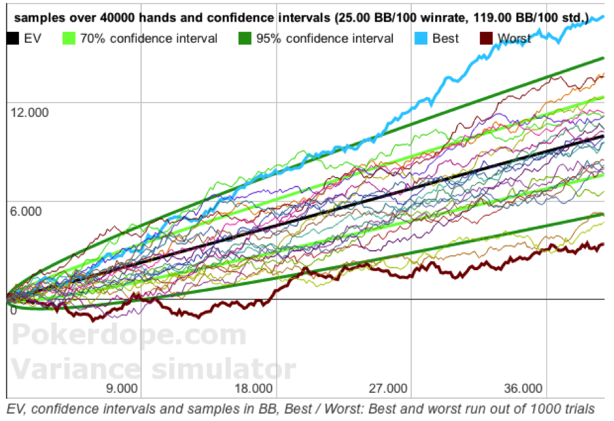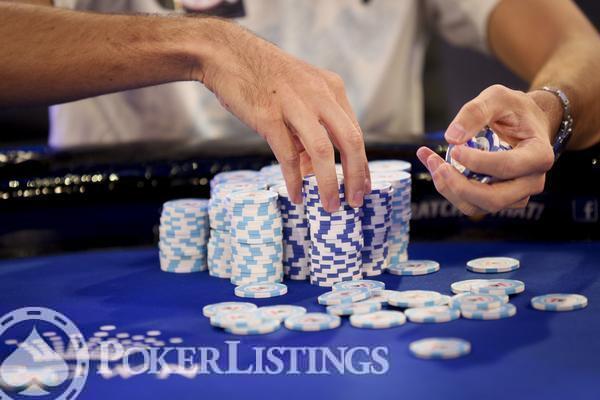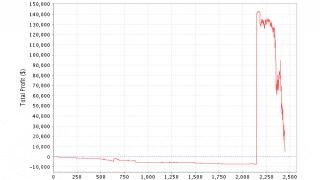Variance isn't a dirty word in poker per se, but for most of us it’s a very theoretical term and only few of us understand what it actually means.
Variance has a lot to do with mathematics, which – again – is not a dirty word but a science that makes sure our cars drive, our planes fly and our smart phones are smart (to some extent at least).
To understand what variance means one does not have to study probability theory or know that the abbreviation CLT means “Central Limit Theorem."
It’s actually a lot simpler than that. Basically in poker variance is a term (or more specifically a number) which describes how far your results spread around the mean.
To put it simpler – a lot of variance means many swings; less variance means fewer swings. But let’s look at an example to get a better grasp at the concept of variance in poker and put some numbers on it.
Variance in Live Poker
Let's take a look at a decent low-stakes live poker player. We'll call him John.
John plays $1/$2 No-Limit Hold’em in his local casino. He plays 20 days per month and averages six hours of play per day.
He usually plays between 30 and 35 hands per hour. Thus in total he plays about 4,000 hands per month.
Now since John is a decent player he usually wins at his game. Per month he averages $2,000 profit after rake and tips. So his win rate is $50 per 100 hands.
Of course John doesn’t win uniformly every day. He has good days where he wins a ton and bad days where he loses quite a bit. “Good days and bad days” – that’s his variance.
Now let’s try to put a number on John’s variance. Therefore we ask him for one month to accurately write down his results every 100 hands.
So John produces this chart for us:
| $50 | $180 | $0 | $160 | -$190 | $140 | $440 | -$200 |
| -$300 | $230 | $230 | $320 | $130 | $390 | $330 | $340 |
| $200 | -$220 | $130 | $640 | -$170 | $90 | -$50 | -$120 |
| -$270 | -$200 | -$260 | $20 | $90 | -$160 | $0 | -$340 |
| $190 | -$250 | $120 | -$300 | $400 | $90 | $200 | -$80 |
Those are John’s winnings for each 100-hand-stretch. If you add up those 40 numbers it’s exactly $2,000. But for individual stretches his results range from $340 losses to $640 wins.
On average we expect John to win $50 per 100 hands, but let’s take a closer look at his variance.
Therefore we calculate the average difference from his expected winnings ($50 per 100 hands) for all forty 100-hand-stretches (a program like excel comes in quite handy here because it has built in formulas to do those calculations).
We did this calculation and it turns out the average difference is $238. This number is called standard deviation.
This means John will miss his expected winnings of $50 per 100 hands by $238 on average – either by winning way more than $50 or by losing over a single 100-hand-stretch.
The 3 Magic Numbers for Variance in Poker
Now we've gathered the three important numbers to fully understand variance:
- Win Rate: In the case of John: $50 per 100 hands
- Standard Deviation: In the case of John: $238 per 100 hands
- Number of Hands Played: In the case of John: 4,000 (for one month)
Those three numbers are all we need to run a bunch of tests, explain John’s results over long periods and even make educated guesses about his future winnings.
We take those three parameters (win rate, standard deviation and number of hands) and head to over to any variance calculator to get some more insight into the variance John can expect.

Now what do we see here? Firstly the calculator shows 20 simulated samples how John might perform over the course of one month (the thin colored lines).
It also shows the best and worst run out of 1,000 trials (the bold blue and red lines).
The bold green lines show the confidence intervals. The two dark green lines are the most important ones – they indicate the 95-per cent confidence interval.
This term means that in 95 per cent of all cases the actual results will be somewhere between those lines. Meaning: at any given time there’s only a 5 per cent chance that his winnings will be above the upper dark green graph or below the lower dark green graph.
Let’s take a closer look at some numbers the variance calculator produces:
- The probability that John does not make any profit over 4,000 hands is 9.2 per cent.
- 5 per cent of the time John will be stuck in a downswing over more than $2,000 (1,000 big blinds).
- 3 to 4 per cent of the time John will be stuck in a downswing over more than 10,000 hands (that’s two-and-a-half months if he plays 4,000 hands per month).
- On average John can expect to win $2,000 per month but there’s a 5 per cent chance that he will either win more than $5,000 in one month or lose at least $1,000 in one month.
To put those numbers into a single, simple sentence: John may expect some wild rides and should not be too surprised if he has a losing month and should not boast excessively if he has a very good month.
Now what happens to his variance if John plays more than just one month?
Naturally one would expect the variance to have a lesser impact when playing more. So let’s assume John plays for 10 months (40,000 hands) with the same win rate ($50 or 25 big blinds per 100 hands) and the same standard deviation ($238 or 119 big blinds per 100 hands).
Here's what the variance calculator shows:

Now those lines look much friendlier – all of them go up. And even the worst run out of 1,000 trials is way above the zero line.
In fact, let’s take a closer look at some numbers:
- The probability of John losing money over 40,000 hands (10 months worth of live poker) is miniscule: 0.001 per cent.
- In 95 per cent of all trials John will win between $10,400 and $29,500 over 10 months.
Those numbers lead to one conclusion:
- Very good live cash game players have no variance problems
The example we just went through shows that after a few months of play a good live cash-game player can expect to simply outlast any negative variance he might encounter along the way.
If you’re good enough and your win rate is high enough, you will come off well despite any downswing you might stumble into.
But the example also shows that over short periods of time you must take variance into consideration. In our example there’s a very realistic chance of having a losing month (9.2 per cent).
So you should always make sure your bankroll can handle those short-term swings.
Variance in Online Poker
Remember how we said variance isn't a particularly big problem for the good, live cash-game player? It's a very different story for online poker players.
In particular there's one major elephant in the room that needs to be approached with caution: win-rate.
Obviously there are a bunch of differences between live poker and online poker (and some people might even go so far as to call it a completely different game). The most important for us related to variance are:
1. Online poker is played much faster
A (semi) professional online player plays more than one table and will average from 200 to more than 1,000 hands per hour (the live player usually never sees more than 35 hands per hour).
2. Online poker usually has a lower standard deviation per 100 hands
Live players need three hours to play 100 hands and can experience the wildest swings over this period. Online you might only need 10 minutes to play 100 hands and will usually experience fewer swings over this period (partly due to the fact that the games are tighter in general).
3. The most important point: online poker players usually have much lower win rates than live poker players
While low-stakes live players might be able to beat their limit by 25 big blinds per 100 hands those win rates are unheard of nowadays in the online poker world. The competition is much better and win rates of five big blinds per 100 hands are already considered to be excellent.
While the first two points (more hands, lower standard deviation) might indicate that online poker has lower overall variance than live poker, the third point (lower win rates) ensures that variance is a major factor online.
Variance is Big Deal in Online Poker
To show how major this variance-factor is, let’s return to John for a moment. John – our live poker grinder from our previous examples – just discovered the online poker world and he’s as decent online as he is in his local casino.
Let’s say he beats the $0.50/$1 No-Limit Hold’em tables online with a win rate of five big blinds per 100 hands (which is already way above average for decent players).
His standard deviation is 100 big blinds per 100 hands (that’s a usual standard deviation for six-max tables online).
Live, John plays 4,000 hands per month, so let’s see how he does online over this period. Again we head over to the Pokerdope.com variance calculator, enter the three parameters (win rate, standard deviation and number of hands) and take a look at the results:

See what’s happening here? Those samples go wild!
Over 4,000 hands John can expect to win 200 Big Blinds (which corresponds to $200 at the $0.50/$1 tables) on average, but he will encounter plenty of very hefty swings.
Let’s go through some numbers:
- The probability of John losing money over 4,000 hands is 38%
- There’s a 2.5% chance (once every 40 trials) that John will lose more than $1,000 (10 or more buy-ins) over 4,000 hands
- In fact more than 30% of the time John will be stuck in a downswing for more than $2,000
Compare those numbers to John’s live poker performance. Live, his chances of losing money over 4,000 hands were only about 9%.
So why is variance so devastating online?
Variance is a Bitch
The reason why variance has such a huge impact was already given above: win rate. A decent online player might win five big blinds per 100 hands -- maybe 8-10BB per 100 if he or she’s really brilliant and playing at a relatively low level.
While in theory that’s a nice number it’s only a tiny fraction of this player’s standard deviation over 100 hands.
This means that variance will kick you in the butt every now and then and there is not much you can do about it. Your win rate is simply too low to negate a big downswing within a couple of hundred hands.
You might need thousands (maybe even tens of thousands) of hands to recover from your downswings.
If you sit down at an online poker table and expect to roll over it and come out ahead like you might in your local casino, you will be in for a nasty surprise:
- Your online opponents are usually not half-drunk locals or tourists
- Your online opponents are (mostly) sober and usually know what they are doing
- Your online opponents might have hundreds of thousands hands worth of experience and grind the tables for a living
So even if you’re winning, you’re winning by a much smaller margin than live. And a smaller win rate leads to bigger downswings and significantly increased (negative) variance.
Related Reading:
More Hands, Less Variance
Let’s take a look a look at how to counter this variance problem.
The key to getting your variance under control is to play more hands. Almost all professional online grinders play tens of thousands of hands per month – some even play more than 100,000 hands (each month and every month).
If you're a winning player accumulating more hands will inevitably reduce the impact of any short-term variance. The downswings wont just vanish, but you’ll out-win them eventually.
So let’s – again – return to John from our previous examples. He decided to give online poker a real shot and started playing 20 days per month, averaging 2,000 hands per day (playing 4 to 6 hours per day).
Per month he’s playing 40,000 hands. He plays $0.50/$1 No-Limit Hold’em and averages a win rate of five big blinds per 100 hands. His standard deviation is 100 big blinds per 100 hands.
What results can John expect for one month of playing? Well, let’s enter those numbers into the variance calculator:

While still looking quite wild, this simulation does not look too bleak.
- There’s only a 16% chance that John will end up with a losing month
- There’s a 5% chance that John will either lose more than $2,000 or win more than $6,000 in one month
After 40,000 hands variance still is a factor, but it’s already a much smaller one than over only 4,000 hands.
We can also simulate John’s possible results over 400,000 hands (which is 10 months worth of play for John):
- The chance of losing money over 10 months (400,000 hands) is tiny: 0.08%
- The chance of winning an amount somewhere between $7,350 and $32,650 is 95%
- The chance of being stuck in a $2,000 downswing at any given time is slightly over 30%
- The chance of being stuck in a $5,000 downswing (that’s 50 buy ins!) at any given time is around 4%
While those numbers might still look intimidating, unfortunately that’s the best one can come up with. Playing well, avoiding tilt and amassing plenty of hands is the only way to deal with downswings.
Those numbers also show: if you’re a decent (meaning: winning) player, you can negate negative variance by playing the necessary volume.
Related Reading:
Take Control of Poker Variance
We've already established that variance is a bitch and there’s one way online poker certainly does not work: You cannot just play one or two tables a couple of hours per week and expect to consistently make money.
If those are your hopes and expectations, online poker is probably not for you.
You either work on your game and play a decent volume or you learn to live with the fact that variance is a huge factor and whether you have a winning or losing month is mostly determined by luck.
You also should not overvalue upswings or downswings too much. They will happen more frequently and on a larger scale than you expect anyway.
Just because you won 10 buy-ins in a couple of hours you’re not the second coming of Vanessa Selbst. And just because you dumped 10 buy-ins over two evenings you’re not necessarily a bad player.
Even players at low stakes and who play mostly for competitive reasons (and not to pay their bills) should become accustomed to the fact that they will need a lot of endurance to consistently beat their limit.
But this does not mean variance cannot be your bitch, once and for all. Yes, everybody can run badly. But on the other hand everybody can run well, too.
It’s known to happen that sub-par players score huge in big tournaments (think Jamie Gold or Darwin Moon hitting 1st and 2nd place in the WSOP Main Event).
It’s always possible to land a lucky punch in a poker tournament ... but it's a completely different story to take poker seriously and learn to win consistently.











